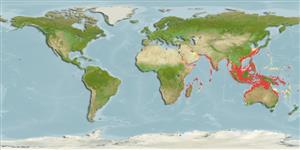Teleostei (teleosts) >
Tetraodontiformes (Puffers and filefishes) >
Diodontidae (Porcupinefishes (burrfishes))
Etymology: Cyclichthys: Greek, kyklos = round + Greek, ichthys = fish (Ref. 45335).
More on author: Bloch.
Environment: milieu / climate zone / depth range / distribution range
Ecology
Marine; reef-associated; depth range 9 - 170 m (Ref. 30573). Tropical; 32°N - 36°S, 24°E - 168°E
Indo-West Pacific: Red Sea and East Africa to the Philippines, north to southern Japan, south to Australia and New Caledonia (Ref. 9680). Southeast Atlantic: south coast of South Africa (Ref. 4423).
Size / Weight / Age
Maturity: Lm ? range ? - ? cm
Max length : 30.0 cm TL male/unsexed; (Ref. 9710)
Inhabit clear protected reefs with sponge and algal habitats. Often in large sponges during the day (Ref. 48637). Usually over sand and mud bottoms to at least 170 m (Ref. 30573). Occasionally on reefs (Ref. 9680). Active at night, feeding among reefs (Ref. 48637). A nocturnal species (Ref. 9710) that presumably feeds on hard-shelled invertebrates (Ref. 9680, 48637).
Life cycle and mating behavior
Maturities | Reproduction | Spawnings | Egg(s) | Fecundities | Larvae
Randall, J.E., G.R. Allen and R.C. Steene, 1990. Fishes of the Great Barrier Reef and Coral Sea. University of Hawaii Press, Honolulu, Hawaii. 506 p. (Ref. 2334)
IUCN Red List Status (Ref. 130435)
Threat to humans
Harmless
Human uses
Fisheries: subsistence fisheries; gamefish: yes
Tools
Special reports
Download XML
Internet sources
Estimates based on models
Preferred temperature (Ref.
123201): 22.3 - 28.3, mean 26.8 °C (based on 908 cells).
Phylogenetic diversity index (Ref.
82804): PD
50 = 0.6250 [Uniqueness, from 0.5 = low to 2.0 = high].
Bayesian length-weight: a=0.04786 (0.01967 - 0.11644), b=2.82 (2.61 - 3.03), in cm total length, based on LWR estimates for this (Sub)family-body shape (Ref.
93245).
Trophic level (Ref.
69278): 3.6 ±0.59 se; based on food items.
Resilience (Ref.
120179): High, minimum population doubling time less than 15 months (Preliminary K or Fecundity.).
Fishing Vulnerability (Ref.
59153): Low vulnerability (20 of 100).
Nutrients (Ref.
124155): Calcium = 42.4 [18.3, 107.2] mg/100g; Iron = 0.615 [0.316, 1.398] mg/100g; Protein = 18.3 [16.1, 20.5] %; Omega3 = 0.131 [0.068, 0.252] g/100g; Selenium = 46.2 [23.0, 97.4] μg/100g; VitaminA = 52.3 [15.0, 197.6] μg/100g; Zinc = 1.05 [0.70, 1.56] mg/100g (wet weight);
